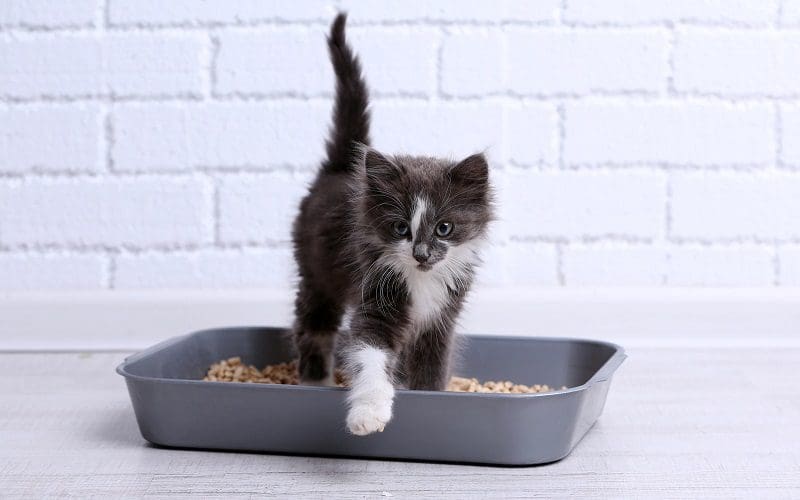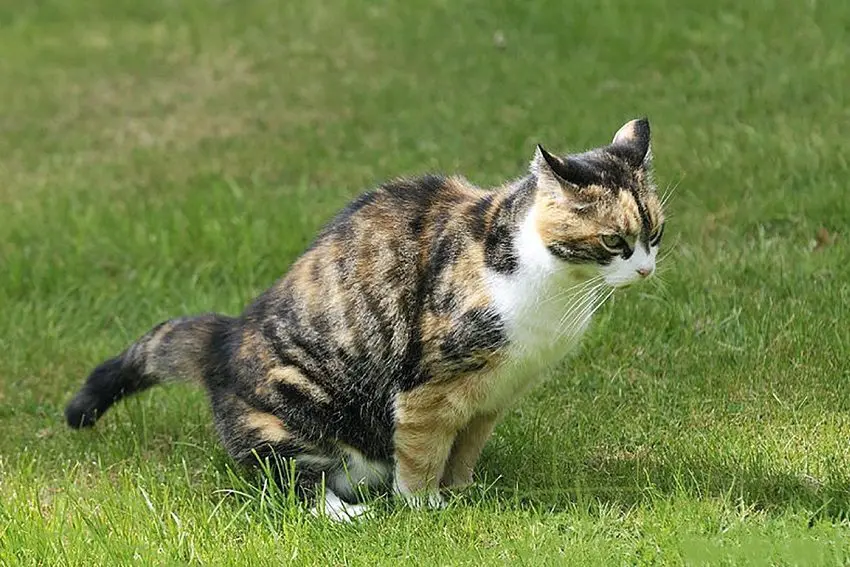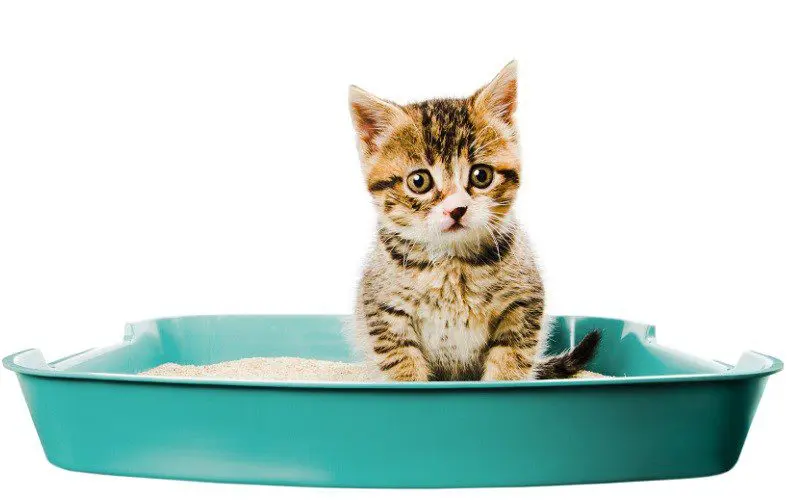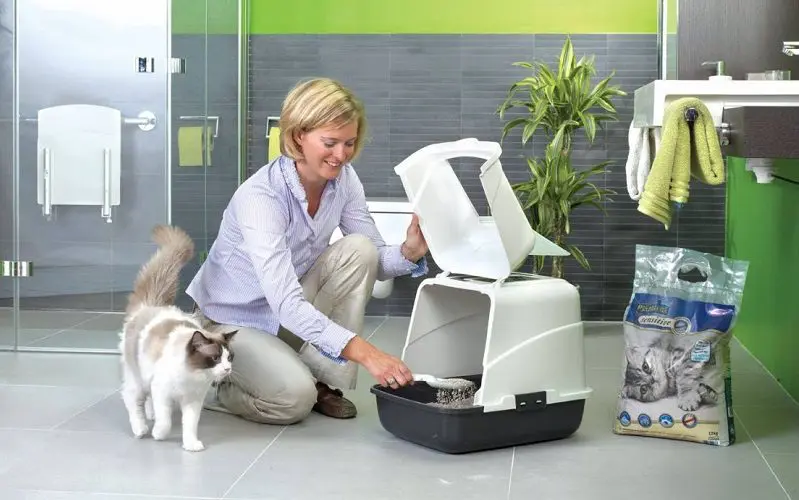Last Updated: 2 months ago
How do you tell if your cat’s pee is normal? We bring you four tips for determining if a kitty is healthy based on the cat pee you see in the litter box!
Let’s face it, your cat is not going to let you watch him or her urinate in order to tell if their urine is normal or not.
They prefer to be left alone to use the litter box, so keeping an eye on them doing it is not going to happen.
So how else can you tell if your cat is urinating normally, if it is indeed normal, or if there is something wrong?
What Is Cat Pee?
Urine, also known as cat pee, is the collection of excess water and substances not being used any longer by the body.
The kidneys send their excess substances to the bladder via tubes called ureters. Urine then collects in the bladder until it is ready to be eliminated from the body through a tube called the urethra.
Urine color can tell us about our cat’s health. A healthy cat will produce urine that ranges from pale yellow to amber in color.
If your cat’s urine appears dark or cloudy, this could indicate an infection or other medical issue that needs attention.
Changes in consistency can signal a problem. For example, if your cat’s urine becomes foamy or bubbly it may be indicative of kidney disease or diabetes.
The amount of urine produced can also provide insight into your pet’s health status. If they are producing too much (polyuria) or too little (oliguria), it could mean something more serious than just dehydration.
When Do Cats Pee?

Cats will usually start sniffing around or scratching in preparation before going, which are both cues that they need access to a clean litter box soon.
If your cat is straining or making frequent trips back and forth from the litter box without success, this could indicate a urinary tract infection (UTI) or other medical issues that require veterinary attention.
If you notice any changes in your cat’s bathroom habits such as increased frequency of urination or difficulty passing urine, then contact your vet immediately.
It’s also important for owners to keep an eye out for any blood in the urine which could be indicative of serious medical conditions like kidney stones or bladder infections requiring urgent care.
In general, cats prefer having multiple litter boxes throughout the house so they always have easy access when needed.
How Many Times a Day Do Cats Pee?
Healthy adult cats produce an average of 28 ml/kg (milliliters per kilogram) of urine every 24 hours.
This means that for a 10-pound cat, this would be approximately half a cup, although this number may vary depending on factors such as age and activity level.
Most adult cats should urinate at least once every 24 hours but this number varies depending on age and size.
Kittens tend to go more frequently due to their smaller bladders while senior cats may only go every few days because their bodies don’t process liquids as efficiently anymore.
If your cat is drinking more than usual but not producing more urine than normal, then it could be an indication of diabetes or kidney disease, which should be discussed with your veterinarian right away.
It could also indicate dehydration due to illness or even just a lack of access to fresh water. Both scenarios warrant further investigation by a vet as soon as possible.
How to Tell if Cat Pee is Normal

Here are several ways to tell if your cat’s urine is normal:
- Color and Clarity: Normal urine is typically pale yellow to amber in color and clear. Cloudiness or a drastic color change may indicate issues.
- Odor: Healthy cat urine has a mild ammonia-like scent. Strong or foul odors could signal infection or other health problems.
- Frequency: Cats usually urinate 2-4 times a day. A sudden increase or decrease in frequency may be a cause for concern.
- Litter Box Habits: Changes in litter box behavior, such as straining, vocalizing, or avoiding the box, may indicate urinary issues.
- Volume: While the normal amount varies, drastic increases or decreases in urine volume should be monitored and discussed with a vet.
- Presence of Blood: Blood in the urine (hematuria) can be a sign of various conditions, and it requires prompt veterinary attention.
- Pain or Discomfort: If your cat shows signs of pain or discomfort while urinating, it may be indicative of a urinary tract issue.
Monitoring these aspects regularly can help you assess your cat’s urinary health and identify any potential problems early on.
If you notice significant changes, consult with your veterinarian for a thorough examination.
Normal Cat Urine Signs
Normal cat urine is supposed to be clear and pale yellow. Some call it straw-colored.
You should be able to see through it, even though that’s not always easy because cat litter covers it up.
If you have an adult cat that is spayed or neutered, their urine smell should not be overwhelming or offensive.
This will be normal cat urine, acidic, and slightly pungent.
Frequency of Urination

Cats typically do not urinate as much as dogs or humans on a daily basis.
While some cats may only urinate twice a day, there are some that might urinate more often, but that doesn’t necessarily mean they are having any urinary issues, so don’t panic.
You will know your cat’s habits; if they urinate usually twice a day but have recently started to do so more than their usual time, then it’s time to try monitoring their urination so you can explain to the veterinarian what is going on.
Be sure to keep an eye on them if they are urinating less than normal, especially in male cats, because the cause could be something minor, like their bladder having crystals that are blocking their urination path.
This could lead to surgery, or even worse, when not treated appropriately and immediately.
Abnormal Urination
Oftentimes, when a cat is having trouble with their kidneys or bladder, they tend to urinate on the outside of the box instead of inside.
If they are having trouble with urination from bladder infections, blockage, diabetes, dehydration, or another feline ailment, they may urinate in unusual places as a signal to get your attention, and the issue should be addressed immediately after you find out about it.
Odor or Color

Since the normal color of cat urine is clear, pale yellow, as we discussed earlier, any color changes should be addressed.
Some that may occur are urine with no color at all, orange-colored urine, and blood in urine. Basically, if it is enough for you to notice it, then the issue should be checked out right away.
The same thing goes for the smell; if you notice any changes, be sure to contact your veterinarian as soon as possible.
When to See The Vet
While cats typically pee several times a day, there are certain signs that may indicate they are either urinating too much or not enough.
Watch out for these signs when they pee:
- Increased Frequency: If you notice that your cat is urinating more frequently than normal (more than once per day), this could be an indication of a health issue and should be addressed by a vet immediately.
- Blood in Urine: If there is blood present in their urine, this can indicate an infection or other medical condition and requires immediate medical attention.
- Difficulty Urinating: Cats who are straining to urinate or having difficulty doing so may have an obstruction or blockage which needs to be cleared as soon as possible.
- Sudden Changes in Habits: Any sudden change in urinary habits could signal something serious and should warrant a visit with the vet for further evaluation.
FAQs
How to Monitor Your Cat’s Pee?
To monitor your cat’s pee, observe litter box habits, noting frequency, color, and any changes. Watch for signs of discomfort or changes in behavior during urination.
How Much Cat Pee Is Normal?
The normal amount of cat pee varies, but cats generally produce 2-4 ounces daily. Changes in volume may signal health issues, so monitor for drastic increases or decreases and consult your vet if concerned.
Wrap-Up
These are the common ways to tell if your cat’s urination is normal or not.
Being pet parents, we want what is best for our furbabies, so keeping an eye on them is not uncalled for.
After all, they are part of our family, and we always want our families to be happy and healthy.
Do you have any tips to add to the ones we listed for how to tell if your cat’s urine is normal? Feel free to comment and let us know!

Dr. Linda Simon MVB MRCVS is a locum veterinary surgeon who has worked in London for the past 8 years. She graduated top of her class in small animal medicine from UCD, Dublin. She is currently a member of the Royal College of Veterinary Surgeons. Linda is the resident vet for Woman magazine and a frequent contributor to People’s Friend Magazine, the Dogzone website, Vet Help Direct and Wag! Linda also writes content for the CVS veterinary group, Vetwriter and a number of other establishments.
